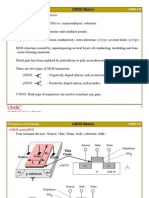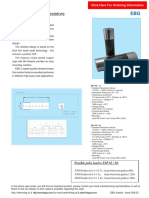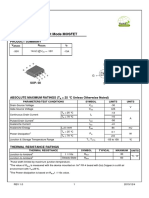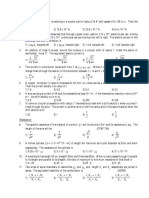CMOS Basics
Advanced VLSI Design
CMPE 640
MOS: Metal Oxide Semiconductor
Transistors are built on a Silicon (semiconductor) substrate.
Pure silicon has no free carriers and conducts poorly.
Dopants are added to increase conductivity: extra electrons (n-type) or extra holes (p-type)
MOS structure created by superimposing several layers of conducting, insulating and transistor-forming materials.
Metal gate has been replaced by polysilicon or poly in modern technologies.
There are two types of MOS transistors:
nMOS
: Negatively doped silicon, rich in electrons.
pMOS
: Positively doped silicon, rich in holes.
CMOS: Both type of transistors are used to construct any gate.
�CMOS Basics
Advanced VLSI Design
CMPE 640
nMOS and pMOS
Four terminal devices: Source, Gate, Drain, body (substrate, bulk).
Source
Source
Gate
p substrate
Drain
Polysilicon
Thin
Oxide
SiO2
Drain
L
n+
Gate
nMOS
n+
n+
p
n+
Source
Gate
bulk Si
Drain
Polysilicon
SiO2
pMOS
p+
p+
n
bulk Si
�CMOS Basics
Advanced VLSI Design
CMPE 640
CMOS Inverter Cross-Section
Cadence Layer's for AMI 0.6mm technology
p-substrate contact (cc)
p-diffusion contact (cc)
(source)
metal1
n-substrate contact (cc)
m1-m2 contact (via)
metal2
n-diffusion contact (cc)
(Out)
(source)
glass(insulator)
VDD
GND
(pactive)
layer #3
layer #2
p+
n+
p+
n+
(drains)
p+
n+
layer #1
n-well (nwell)
(nactive)
p substrate (black background)
n-transistor polysilicon gate (poly )
p-transistor
3
�Advanced VLSI Design
CMOS Basics
CMPE 640
CMOS Cadence Layout
Cadence Layout for the inverter on previous slide
�CMOS Basics
Advanced VLSI Design
CMPE 640
MOS Transistor Switches
We can treat MOS transistors as simple on-off switches with a source (S), gate (G) (controls the state of the switch) and drain (D).
1 represents high voltage, VDD (5V, 3.3V, 1.8V, 1.2V, <=1.0V today, .....)
0 represent low voltage - GND or VSS. (0V for digital circuits)
d
nMOS
pMOS
g=0
g=1
d
OFF
ON
OFF
ON
s
�CMOS Basics
Advanced VLSI Design
CMPE 640
Signal Strengths
Signals such as 1 and 0 have strengths, measures ability to sink or source current
VDD and GND Rails are the strongest 1 and 0
Under the switch abstraction, G has complete control and S and D have no effect.
In reality, the gate can turn the switch on only if a potential difference of at least Vt
exists between the G and S.
We will look at Vt in detail later on in the course.
Thus signal strengths are related to Vt and therefore p and n transistors produce signals with
different strengths
Strong 1: VDD, Strong 0: GND, Weak 1 :(~VDD -Vt) and Weak 0 :(~GND + Vt).
nMOS
G 1
S
0
*** Strong 0***
1
Weak 1
pMOS
G 0
0
Weak 0
1
*** Strong 1***
6
�CMOS Basics
Advanced VLSI Design
CMPE 640
CMOS Inverter
Vdd
P1
A
Out
N1
CMOS Inverter
THE CONFIGURATION BELOW FOR A BUFFER IS NOT A GOOD IDEA. WHY?
A
P1
Vdd
N1
BAD IDEA
Out
�CMOS Basics
Advanced VLSI Design
CMPE 640
NAND and NOR CMOS Gates
Vdd
A
P1
A
B
P2
Out
N2
N1
Vdd
A
P1
P2
N1
A
B
B
Out
N2
�CMOS Basics
Advanced VLSI Design
CMPE 640
Pass Transistor
The off-state of a transistor creates a high impedance condition Z at the drain.
No current flows from source to drain. So transistors can be used as switches.
g=0
g
s
Input g = 1 Output
0
strong 0
g=1
s
d
g=1
s
1
Input
g=0
g
s
g=1
degraded 1
g=0
Output
degraded 0
g=0
strong 1
However, as we previously discussed this will produce degraded outputs, if only one
transistor is used as a switch.
9
�CMOS Basics
Advanced VLSI Design
CMPE 640
Transmission Gates
A
P1
N1
A
In
One pMOS and one nMOS in parallel.
Note that neither transistor is connected to VDD or GND.
Out
A and A control the transmission of a signal on In to Out.
Transmission gates act as tristate buffers.
Input
g
a
b
gb
b
gb
g = 0, gb = 1
a
b
g = 1, gb = 0
0
strong 0
g = 1, gb = 0
a
b
g = 1, gb = 0
strong 1
1
g
a
g
b
gb
Output
b
gb
10
�CMOS Basics
Advanced VLSI Design
CMPE 640
Transmission Gate Application: Select Mux
Transmission Gate
2-to-1 MUX
Select
A
In
Out
Select
Out
Select
Truth Table for 2-to-1 MUX
Select
Out
VDD
Select
Out = A.S + B.S
How many transistors are required to implement this using CMOS gates?
11
�CMOS Basics
Advanced VLSI Design
CMPE 640
D Latch
Positive
level-sensitive
latch
CLK
Latch
CLK
Q
Q
CLK
D
CLK
Q
Q
0
CLK
If CLK is unavailable one extra inverter
needed to generate it using CLK
CLK
CLK
12
�CMOS Basics
Advanced VLSI Design
CMPE 640
D Flip-Flop
Positive
edge-triggered
flip-flop
a.k.a
master-slave
flip-flop
CLK
CLK
D
Flop
Q
Q
CLK
CLK
CLK
QM
D
CLK CLK Master
QM
Master
Latch
Latch
CLK
Slave
Q
CLK CLK Slave
Q
CLK
CLK
If CLK is unavailable one extra inverter needed to generate it using CLK
13
�CMOS Basics
Advanced VLSI Design
CMPE 640
D Flip-Flop Operation
D
QM
QM follows D, Q is latched
CLK = 0
QM
QM transferred to Q, QM latched
CLK = 1
CLK
Positive
edge-triggered
flip-flop
D
Q
14
�CMOS Basics
Advanced VLSI Design
CMPE 640
More CMOS Gates
Vdd
B
P1
Vdd
A
P2
Out
N2
N1
15
�CMOS Basics
Advanced VLSI Design
CMPE 640
And More CMOS Gates
A
B
Out
16
�CMOS Basics
Advanced VLSI Design
CMPE 640
And More CMOS Gates
Vdd
P2
P1
P3
P4
OAI
N1
B
C
N2
N3 N4
17











































































































